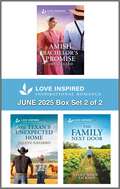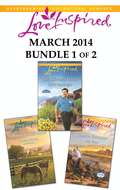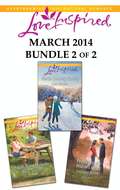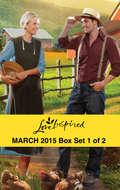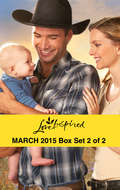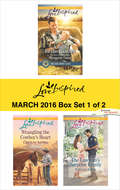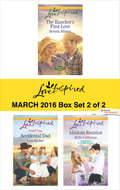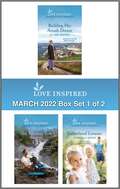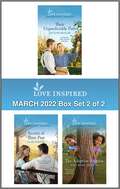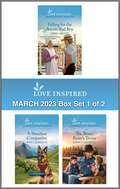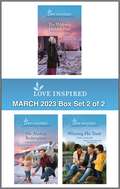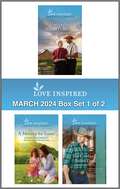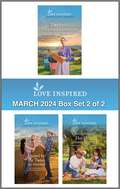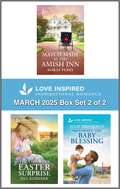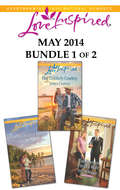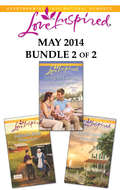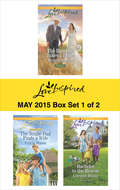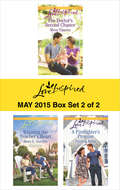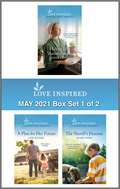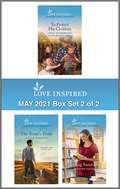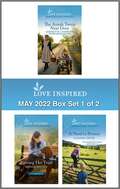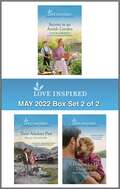- Table View
- List View
Love Inspired June 2025 Box Set 1 of 2
by Jo Ann Brown Susanne Dietze Lee Tobin McClainLove Inspired brings you three new titles! Enjoy these uplifting contemporary romances of faith, forgiveness and hope.This box set includes:SAVING HER AMISH BABY (An Amish of Lost River novel) by Jo Ann BrownWhen Amish seamstress Emma Weaver takes in her cousin&’s abandoned baby, she vows to give the boppli a life better than she had growing up. But this proves to be a challenge when her rented cabin is no longer safe to live in. Reluctantly, she accepts help from Tyler Lehman, whose generosity slowly begins to win over her battered heart. But as Emma worries about her place in little Josie&’s future and Tyler questions if he belongs in the Amish world, can they become a true family? HOLDING ONTO SECRETS (A K-9 Companions tale)by New York Times bestselling author Lee Tobin McClainTo support his sister and young nephew, handyman Luke Johnson is in desperate need of a new job. His prayers are answered when Angie Anderson hires him to help renovate her property to house and train therapy dogs. Grieving widow Angie hopes to rebuild her life with a new sense of purpose, and establishing a therapy-dog reading program is just the fresh start she needs. Soon, unexpected feelings begin to grow between them, but will the secret Luke&’s keeping threaten their chance at a future together?MOUNTAIN HOMECOMING (A Home to Foxtail novel)by Susanne DietzeAfter months away, architect Wyatt Teague returns home only to find himself named a guardian to his late friends&’ orphaned twins…alongside his ex-fiancée, Natalie Dalton. But caring for them together proves to be a challenge: Wyatt&’s job is in the city, and Natalie can&’t leave her family&’s apple orchard. As they vow to make this new partnership work, old feelings between them quickly resurface. But when Natalie finds out the true reason behind Wyatt&’s abandonment, can she trust him with the babies…and her heart?For more stories filled with love and faith, look for Love Inspired June 2025 Box Set – 2 of 2
Love Inspired June 2025 Box Set 2 of 2
by Jolene Navarro Amy Lillard Zoey Marie JacksonLove Inspired brings you three new titles! Enjoy these uplifting contemporary romances of faith, forgiveness and hope.This box set includes:THE AMISH BACHELOR&’S PROMISEby Amy LillardAfter years of overlooking his best friend, Amish farmer Freeman Yoder finally begins to see Evie Ebersol through new eyes. But Evie is convinced that she would be a rebound—and that her physical challenges would be a burden. Despite loving Freeman for most of her life and yearning for a family and home of her own, she refuses to hold Freeman to his decades-old promise to marry her. Now he&’s determined to show Evie that she&’s the only one he wants to build a future with.THE TEXAN&’S UNEXPECTED HOME (A Ranchers of Rio Bella story)by Jolene NavarroAfter losing everything in a devastating fire, racehorse trainer Kingston Zayas returns to his family&’s ranch to claim his inheritance…and learns that he must first live there for a year. The only silver lining? Single mom Abigail DeLeon, the ranch&’s event planner, and her energetic son, Leo. But Abigail&’s family wants nothing to do with any Zayas. Forced to work together, they unravel a tangle of secrets that changes everything Kingston thought he knew about his family—and most important, where he belongs…THE FAMILY NEXT DOORby Zoey Marie JacksonAfter her business goes under, Torryn Emerson is only too happy to return to her hometown and restore the house left to her in her mother&’s will. She never expects to find friendship next door. Matthew Lawson finds it difficult to connect with his young son after his wife&’s death. So when Connor is drawn to their fun-loving neighbor, Torryn, Matthew asks for her help. As they spend more time together, Torryn can&’t help but fall for the little boy and his father…but can they overcome past hurts to become the family they need?For more stories filled with love and faith, look for Love Inspired June 2025 Box Set – 1 of 2
Love Inspired March 2014 - Bundle 1 of 2
by Linda Goodnight Leann Harris Mia RossEnjoy these uplifting contemporary romances of faith, forgiveness and hope. This Love Inspired bundle includes The Lawman's Honor by Linda Goodnight, Seaside Romance by Mia Ross and A Ranch to Call Home by Leann Harris.<P> THE LAWMAN'S HONOR: As assistant police chief, Heath Monroe never expected he'd ever need rescuing. But that's exactly what Cassie Blackwell does when she pulls him out of a car wreckage. He's surprised at the beautiful widow's strength and joyous spirit. But he's been burned before and is cautious to get involved. Especially since his investigation into the town's drug operation might implicate Cassie's ex-husband! Yet the more time he spends with her, the deeper he falls. Will he have to choose between duty and his growing love—or is there a way he can have both? <P> SEASIDE ROMANCE: Running away from her troubled city life, Lauren Foster never thought she'd find herself in small-town Maine. But Holiday Harbor is everything she's looking for. The townspeople are welcoming, her job at her friend's toy store is going well and, most important, she's safe. Meeting contractor Ben Thomas soon changes all that. With his good looks, easygoing nature and kind heart, he's turning her peaceful new life upside down. She's quickly falling for the local hero, but when her past catches up to her present, is she willing to face her fears for the future she's always dreamed of?<P> A RANCH TO CALL HOME: The thrill of the rodeo is gone for cowboy Caleb Jensen. Nowadays, he helps out at a Texas ranch, keeping bad memories locked away. Then the ranch owner's granddaughter unexpectedly returns home—with a request he can't accept. Former army captain Brenda Kaye is organizing a charity rodeo, and she needs Caleb to get back in the saddle. She's determined to save her family's ranch, even if it means working with the smart-aleck cowboy—and uncovering the mysteries that lie in their pasts. Brenda's used to the dangers of war, but if she trusts Caleb, could the next casualty be her heart?
Love Inspired March 2014 - Bundle 2 of 2
by Lois Richer Jean C. Gordon Lorraine BeattyEnjoy these uplifting contemporary romances of faith, forgiveness and hope. This Love Inspired bundle includes North Country Family by Lois Richer, Small-Town Midwife by Jean C. Gordon and Protecting the Widow's Heart by Lorraine Beatty.<P> NORTH COUNTRY FAMILY: After losing his clients' life savings, former broker Rick Salinger went in search of redemption. Now a pastor in the remote Canadian town of Churchill, he focuses on his congregation and working with the kids at a center for troubled boys. But when the center's new nurse arrives with her own struggling son, Rick fears getting too close. Widowed mom Cassie Crockett once lost almost everything because of Rick—and he's not sure she'll ever forgive him. Yet he can't stop his growing feelings for her. He wants to help Cassie and her son build a new life…one that just might include him. <P> SMALL-TOWN MIDWIFE: Autumn Hazard loves being a midwife. But a tragic loss has her doubting the path she's chosen. And her new boss isn't helping. She's worked with Dr. Jonathan Hanlon before, and he's just as handsome and seemingly perfect as ever. His presence could mean trouble for the clinic—and her sensible heart. Jon remembers Autumn, too. She's still beautiful, smart and oblivious to him. Maybe that's for the best—he's leaving the small town as soon as his training's done. Besides, he has secrets of his own, and he can't risk Autumn getting close enough to uncover them. Yet despite all their reservations, working beside each other doesn't feel like work at all…<P> PROTECTING THE WIDOW'S HEART: Ginger Sloan's had enough of heartache. She just wants a peaceful place where she and her son can start over and feel safe. Getting stranded in a lakeside cabin outside Dover, Mississippi, isn't part of her plan. Then again, neither is falling for the cabin's handsome owner. Injured on the job, detective Tyler Durrant retreats to his cabin to heal. He's shocked to find the single mom and her son there. And surprised at the way Ginger affects his heart. For the first time in years, he has hope for the future, but can he convince Ginger that she can find safe haven in his arms?
Love Inspired March 2015 - Box Set 1 of 2
by Leigh Bale Teri Wilson Rebecca KertzLove Inspired brings you three new titles for one great price, available now! Enjoy these uplifting contemporary romances of faith, forgiveness and hope. This Love Inspired bundle includes A Wife for Jacob by Rebecca Kertz, The Forest Ranger's Rescue by Leigh Bale and Alaskan Homecoming by Teri Wilson.Look for 3 new inspirational stories every month from Love Inspired!
Love Inspired March 2015 - Box Set 2 of 2
by Deb Kastner Mia Ross Lee Tobin McclainLove Inspired brings you three new titles for one great price, available now! Enjoy these uplifting contemporary romances of faith, forgiveness and hope. This Love Inspired bundle includes The Cowboy's Forever Family by Deb Kastner, Finding His Way Home by Mia Ross and Engaged to the Single Mom by Lee Tobin McClain.Look for 3 new inspirational stories every month from Love Inspired!
Love Inspired March 2016 - Box Set 1 of 2
by Margaret Daley Carolyne Aarsen Patricia JohnsLove Inspired brings you three new titles at a great value, available now! Enjoy these uplifting contemporary romances of faith, forgiveness and hope. A BABY FOR THE RANCHER Lone Star Cowboy League Margaret Daley Having discovered he's a father to a baby he never knew existed, bachelor Ben Stillwater seeks out a mother for his son. When Ben falls for pretty Lucy Benson, can he convince the busy sheriff to make room for a family? WRANGLING THE COWBOY'S HEART Big Sky Cowboys Carolyne Aarsen Jodie McCauley has agreed to stay at her late father's ranch until her wild horses are trained. Finding the perfect trainer leads her to Finn Hicks--the only man who's ever held her heart. THE LAWMAN'S SURPRISE FAMILY Patricia Johns Police officer Ben Blake is shocked when high school sweetheart Sofia McCray returns home with a little boy she says is his son. After her newspaper job throws them together, Ben will prove he?s the caring dad and husband Sofia seeks. Join HarlequinMyRewards.com to earn FREE books and more. Earn points for all your Harlequin purchases from wherever you shop.
Love Inspired March 2016 - Box Set 2 of 2
by Lois Richer Brenda Minton Belle CalhouneLove Inspired brings you three new titles at a great value, available now! Enjoy these uplifting contemporary romances of faith, forgiveness and hope. THE RANCHER'S FIRST LOVE Martin's Crossing Brenda Minton Back in Martin's Crossing after ten years, Remington Jenkins realizes he's never forgotten the summer romance he once shared with Samantha Martin. Can he face her overprotective family once again and fight for a second chance at forever? ACCIDENTAL DAD Family Ties Lois Richer Becoming the guardian of the twins his late brother hoped to adopt, rancher Sam Denver looks to the children's maternal aunt Kelly Krause for help. But when custody questions arise, they'll have to work together to keep their newly formed family intact. ALASKAN REUNION Alaskan Grooms Belle Calhoune Paige Reynolds is back in Love, Alaska, to rectify her late father's misdeeds--and introduce Cameron Prescott to the daughter she's kept hidden from him. Can Cameron forgive Paige and embrace a happily-ever-after with his first love? Join HarlequinMyRewards.com to earn FREE books and more. Earn points for all your Harlequin purchases from wherever you shop.
Love Inspired March 2022 Box Set - 1 of 2: An Uplifting Inspirational Romance
by Jo Ann Brown Jill Lynn Gabrielle MeyerLove Inspired brings you three new titles! Enjoy these uplifting contemporary romances of faith, forgiveness and hope. This box set includes: BUILDING HER AMISH DREAM (An Amish of Prince Edward Island novel)by Jo Ann BrownOpening a new farm shop on Prince Edward Island is Mattie Albrecht&’s chance at a fresh start. But avoiding her past becomes impossible when Benjamin Kuhns—her old secret crush—offers to help with repairs. As they work together to renovate the shop, will he restore her heart as well? THE VETERAN&’S VOW (A K-9 Companions novel)by Jill LynnMilitary vet Behr Delgado refuses to participate in a service dog therapy program, even though it will help with his PTSD. But Ellery Watson is sure she chose the perfect canine companion to improve his life and vows to work with Behr one-on-one. Can they trust each other long enough to heal? FATHERHOOD LESSONSby Gabrielle MeyerSingle dad Knox Morgan is in over his head caring for his twins alone when his nanny leaves unexpectedly. But when their aunt, Merritt Lane, agrees to take care of the children for the summer, Knox might just find the partner he didn&’t know he was missing. For more stories filled with love and faith, look for Love Inspired March 2022 Box Set – 1 of 2
Love Inspired March 2022 Box Set - 2 of 2: An Uplifting Inspirational Romance
by Allie Pleiter Jocelyn McClay Zoey Marie JacksonLove Inspired brings you three new titles! Enjoy these uplifting contemporary romances of faith, forgiveness and hope. This box set includes: THEIR UNPREDICTABLE PATHby Jocelyn McClayDespite pressure from his parents, shy widower Jethro Weaver does not want to remarry. And enlisting widow Susannah Mast—a woman ten years his senior—into a fake courtship is just what he needs. But what happens when their fake relationship turns into something real? SECRETS OF THEIR PAST (A Wander Canyon novel)by Allie Pleiter Veterinarian Neal Rodgers lands in Wander Canyon in search of his past. When next-door neighbor Tessa Kennedy begs for his help with a litter of kittens, Neal soon finds himself falling for the sweet, small town—and the single mom who might be the key to unlocking the truth… THE ADOPTION SURPRISEby Zoey Marie JacksonAfter a fatal accident leaves her as guardian to her adopted niece, Kelsey Harris worries about the five-year-old&’s emotional recovery—until little Morgan meets her long-lost twin, Mia. But as the girls&’ connection grows, can Kelsey and Mia&’s widowed adoptive father, Zach Johnson, protect their hearts from the children&’s matchmaking schemes? For more stories filled with love and faith, look for Love Inspired March 2022 Box Set – 2 of 2
Love Inspired March 2023 Box Set - 1 of 2: An Uplifting Inspirational Romance
by Emma Miller Myra Johnson Danica FavoriteLove Inspired brings you three new titles! Enjoy these uplifting contemporary romances of faith, forgiveness and hope.This box set includes: FALLING FOR THE AMISH BAD BOY (A Seven Amish Sisters story)by Emma MillerBeth Koffman is furious that Jack Lehman broke her sister&’s heart. But when her family hires him to build their store, she&’s the one elected to oversee the construction. As she gets to know him, she discovers there is more to Jack than meets the eye. Could he be her perfect match?A STEADFAST COMPANION (K-9 Companions)by Myra JohnsonAngus &“Witt&” Wittenbauer lost everything—even his beloved dog. Now he needs a safe place to land, and dog rescue center owner Maddie McNeill could be the answer. With a spring storm threatening, Maddie needs Witt to fix a leaky kennel roof. Can they also mend their broken hearts?THE BRONC RIDER&’S TWINS (A Shepherd&’s Creek novel)by Danica FavoriteConvinced he caused his best friend&’s death, rodeo cowboy Wyatt Nelson wants to look after widow Laura Fisher and her infant twins. And a marriage of convenience is the perfect solution. But as Wyatt begins to fall for the little family, will he let guilt get in the way of his heart?For more stories filled with love and faith, look for Love Inspired February 2023 Box Set – 2 of 2
Love Inspired March 2023 Box Set - 2 of 2: An Uplifting Inspirational Romance
by Rebecca Kertz Heidi McCahan Toni ShilohLove Inspired brings you three new titles! Enjoy these uplifting contemporary romances of faith, forgiveness and hope.This box set includes: THE WIDOW&’S HIDDEN PASTby Rebecca KertzWhile visiting her sister in a neighboring town, widow Alta Hershberger meets handsome preacher Jonas Miller. Though she&’s not looking for love, she can&’t help her attraction to him. And he seems to feel the same. But how can they be together when she&’s running from her secret past?HIS ALASKAN REDEMPTION (A Home to Hearts Bay romance)by Heidi McCahanCrab fisherman Gus Colman is just trying to make a living. But when he&’s injured and stranded in Hearts Bay, he comes face-to-face with Mia Madden—his late best friend&’s fiancée. He works hard to prove he&’s changed, but can Mia ever love another man who risks his life at sea?WINNING HIS TRUSTby Toni ShilohBack home after a breakup, Jordan Wood is determined to prove she can manage her family&’s general store. When single dad Declan Porter offers her a business opportunity, she jumps at the chance. Then she gets to know Declan&’s adorable son, and suddenly their professional relationship turns personal…For more stories filled with love and faith, look for Love Inspired February 2023 Box Set – 1 of 2
Love Inspired March 2024 Box Set - 1 of 2
by Linda Goodnight Tina Radcliffe Jo Ann BrownLove Inspired brings you three new titles! Enjoy these uplifting contemporary romances of faith, forgiveness and hope. This box set includes: UNEXPECTED AMISH PROTECTORS (An Amish of Prince Edward Island tale)by Jo Ann BrownAmish bachelor Lucas Kuepfer wants nothing to do with Aveline Lampel—until they rescue a kidnapped Englisch child. Now Lucas and Aveline are hounded by reporters and discovering they have more in common than anyone suspected. But will their preconceptions keep them from being a perfect match?A MOMMY FOR EASTERby New York Times Bestselling Author Linda GoodnightTwelve years ago, Rachel and Jake&’s marriage ended in heartache. Now he&’s returned to Rosemary Ridge a widower with an adorable daughter. But when old feelings resurface between them, Rachel and Jake find themselves caught between their painful past…and the hope of a future together just in time for Easter.THE COWBOY&’S SECRET PAST (A Lazy M Ranch novel)by Tina RadcliffeWhen the Morgan family patriarch is injured, nurse Hope Burke arrives at the Lazy M Ranch to help him—and see if Trevor Morgan really is the father of her orphaned nephew. But falling for a guarded cowboy with a rocky past might be more than she bargained for…For more stories filled with love and faith, look for Love Inspired March 2024 Box Set – 2 of 2
Love Inspired March 2024 Box Set - 2 of 2
by Jill Kemerer Jennifer Slattery Patrice LewisLove Inspired brings you three new titles! Enjoy these uplifting contemporary romances of faith, forgiveness and hope. This box set includes: THE AMISH BEEKEEPER&’S DILEMMA by Patrice LewisAfter being jilted, Rebecca Hilty moved to Montana to start over as a beekeeper and dreams of inheriting her boss&’s farm. The only thing standing in her way is cranky farmer Jacob Graber. But when faced with an impossible inheritance requirement, will Rebecca marry Jacob…or lose the farm for good?UNITED BY THE TWINS (A Wyoming Legacies novel)by Jill KemererReagan Mayer&’s inherited the perfect building for her new small-town shop. There&’s just one problem: rancher Marc Young wants it, too. But when he&’s suddenly charged with caring for his twin nieces, their dispute is put on pause and Reagan volunteers to help. Will caring for two babies open their hearts to love?RECAPTURING HER HEART (A Sage Creek romance)by Jennifer SlatteryAfter losing her job, single mom Harper Moore returns to her hometown with one goal in mind—leaving again. But first she needs money, even if that means working for her ex-boyfriend, CJ Jenkins. Now the sparks are back and it could mean a second chance…if CJ can give Harper a reason to stay.For more stories filled with love and faith, look for Love Inspired March 2024 Box Set – 1 of 2
Love Inspired March 2025 Box Set - 1 of 2
by Linda Goodnight Allie Pleiter Emma MillerLove Inspired brings you three new titles! Enjoy these uplifting contemporary romances of faith, forgiveness and hope.This box set includes: THE WIDOWER TAKES A WIFE (A Seven Amish Sisters romance)by Emma MillerIn a letter left by his late wife, Amish widower Jon Coblenz discovers her shocking final wish—marry their best friend, Eleanor Koffman. Initially reluctant, Jon quickly realizes the caring woman he grew up with, who already loves his children, is the perfect choice. But first he&’ll need to woo Ellie. Nearing thirty, Ellie knows a husband isn&’t in her future. That is, until Jon makes his intentions known. But as childhood friendship blossoms into genuine love, will the secret behind their beginning lead to its end?RESCUE ON THE FARM (A K-9 Companions tale)by Allie PleiterPoliceman Grant Emerson&’s temporary trip home is turning into a disaster. Instead of selling the family farm, his mom and aunts have opened an animal shelter—and already rescued several puppies! When neighboring single mother Meg Kittering offers to help, the matchmaking sisters are convinced she can cure Grant&’s grumpiness, despite his protests. But behind Meg&’s sunny smiles are struggles Grant can relate to. They&’re both in need of love…but can they help each other accept it?KEEPING HIS PROMISE (A House of Hope novel)by New York Times bestselling author Linda GoodnightAfter receiving an ominous letter, security specialist Brandt James returns to the hometown he escaped—and finds the girl he left behind. Ashamed of his past, Brandt is determined to avoid her and focus on his investigation instead, but Berkley Metcalfe never forgot the foster boy who stole her heart. Or the promise ring he gave her. As old feelings reignite, the childhood sweethearts face painful memories and her wealthy family&’s disapproval. But Brandt&’s keeping a secret from Berkley, and the truth could cost them their second chance…For more stories filled with love and faith, look for Love Inspired March 2025 Box Set – 2 of 2
Love Inspired March 2025 Box Set - 2 of 2
by Marta Perry Jill Kemerer Julie BrookmanLove Inspired brings you three new titles! Enjoy these uplifting contemporary romances of faith, forgiveness and hope.This box set includes: MATCH MADE AT THE AMISH INN (A Brides of Lost Creek story)by Marta PerryRunning the local Amish inn is the only reason Molly Esch has gained back her confidence after being jilted at the altar. When the owner is suddenly injured, Molly&’s sure she&’ll be promoted. Except the owner asks her widowed nephew, Aaron Fisher, for help instead. Now Molly&’s forced to work alongside the handsome single father, and with his grand ideas for change, they clash right away. But their disagreements soon give way to something deeper. Neither wants to risk their heart again, but facing their fears could lead them to a forever partnership…THE COWBOY&’S EASTER SURPRISE (A Wyoming Legacies story)by Jill KemererAs temporary guardian of his three nieces, stable manager Trent Lloyd is in desperate need of a babysitter. His only option: former classmate Gracie French, who&’s back in town and determined to prove she&’s a responsible, independent adult. The girls instantly adore Gracie, and after a fun-packed Easter weekend, Trent fears he&’s not the only one captivated by Gracie&’s charm. But he can&’t forget the wild child he knew in high school. If he can trust Gracie with his nieces, can he also learn to trust her with his heart?HIS UNEXPECTED BABY BLESSINGby Julie BrookmanLuke Russell is content with his quiet, orderly life—until the firefighter finds an abandoned baby at the fire station and his priorities change instantly. Keeping little Tommy safe and happy is all that matters—even if it means partnering with free-spirited foster mom Tessa Duncan. With ten foster children, Tessa&’s house—and life—is anything but peaceful. Caring for a baby with his polar opposite isn&’t easy, but amid all the chaos, Luke&’s beginning to see from Tessa what his own life is missing: warmth, joy…and love.For more stories filled with love and faith, look for Love Inspired March 2025 Box Set – 1 of 2
Love Inspired May 2014 - Bundle 1 of 2
by Lois Richer Felicia Mason Debra CloptonLove Inspired brings you three new titles for one great price, available now! Enjoy these uplifting contemporary romances of faith, forgiveness and hope. This Love Inspired bundle includes Her Unlikely Cowboy by Debra Clopton, North Country Mom by Lois Richer and The Fireman Finds a Wife by Felicia Mason.Look for 6 new inspirational stories every month from Love Inspired!
Love Inspired May 2014 - Bundle 2 of 2
by Ruth Logan Herne Belle Calhoune Rebecca KertzLove Inspired brings you three new titles for one great price, available now! Enjoy these uplifting contemporary romances of faith, forgiveness and hope. This Love Inspired bundle includes Jedidiah's Bride by Rebecca Kertz, Loving the Lawman by Ruth Logan Herne and Forever Her Hero by Belle Calhoune.Look for 6 new inspirational stories every month from Love Inspired!
Love Inspired May 2015 - Box Set 1 of 2
by Felicia Mason Brenda Minton Lorraine BeattyLove Inspired brings you three new titles for one great price, available now! Enjoy these uplifting contemporary romances of faith, forgiveness and hope.THE RANCHER TAKES A BRIDEMartin's CrossingBrenda MintonWhen Oregon Jeffries introduces rancher Duke Martin to the daughter he never knew he had, can they move beyond the mistakes of their pasts and possibly build a future together?THE SINGLE DAD FINDS A WIFECedar Springs Felicia MasonDr. Spring Darling wants a family of her own. But when she falls for single dad David Camden and his little boy, can she get past the architect's plan to ruin her historic family home?BACHELOR TO THE RESCUEHome to DoverLorraine BeattyConnected by a mutual tragedy, Shawn McKinney promises to care for widow Lainie Hollings and her girls. Can working together to restore the town library bridge the gap between these two wounded hearts?
Love Inspired May 2015 - Box Set 2 of 2
by Missy Tippens Jean C. Gordon Patricia JohnsLove Inspired brings you three new titles for one great price, available now! Enjoy these uplifting contemporary romances of faith, forgiveness and hope.THE DOCTOR'S SECOND CHANCEMissy TippensHaving given up her child for adoption years ago, Dr. Violet Remy is given a second chance at the family she's always longed for when new daddy Jake West seeks her help in raising his adorable baby niece.WINNING THE TEACHER'S HEARTThe Donnelly BrothersJean C. GordonSingle mom Becca Norton is fighting Jared Donnelly for the preservation of her neighborhood, yet when she must battle for custody of her children, can this former bad boy come to her family's rescue?A FIREFIGHTER'S PROMISEPatricia JohnsFirefighter Matt Bailey needs a fresh start in a new town. But he can't abandon the boy he once found on his doorstep--or the boy's amazing adoptive mom. Despite his past mistakes, can he be the hero they both need?
Love Inspired May 2021 - Box Set 1 of 2: An Anthology
by Lois Richer Renee Ryan Carrie LighteLove Inspired brings you three new titles! Enjoy these uplifting contemporary romances of faith, forgiveness and hope. This box set includes: HIDING HER AMISH SECRET (An Amish of New Hope novel)By Carrie LighteArleta Bontrager&’s convinced no Amish man will marry her after she got a tattoo while on rumspringa, so she needs money to get it removed. But taking a job caring for Noah Lehman&’s sick grandmother means risking losing her heart to a man who has his own secrets. Can they trust each other with the truth? A PLAN FOR HER FUTURE (A Calhoun Cowboys novel)By Lois RicherRaising his orphaned granddaughter alone seems impossible to Jack Prinz, but he has the perfect solution—a marriage of convenience with his childhood friend. But even as Grace Partridge falls for little Lizzie, convincing her to marry without love might not be so easy… THE SHERIFF&’S PROMISE (A Thunder Ridge novel)By Renee Ryan After Sheriff Wyatt Holcomb and veterinarian Remy Evans clash over her new petting zoo—and her runaway alpaca!—the two strike a bargain. She'll watch the nephew in his care for the summer if he'll push along the permit process. But keeping things strictly professional is harder than either of them expected. For more stories filled with love and faith, look for Love Inspired May 2021 Box Set – 2 of 2
Love Inspired May 2021 - Box Set 2 of 2: An Anthology
by Linda Goodnight Jolene Navarro Susanne DietzeLove Inspired brings you three new titles! Enjoy these uplifting contemporary romances of faith, forgiveness and hope. This box set includes: TO PROTECT HIS CHILDREN (A Sundown Valley novel)By New York Times Bestselling Author Linda GoodnightStruggling to find a nanny for his triplets, rancher Wade Trudeau advertises for a housekeeper instead. So when former teacher Kyra Mason applies, looking for a place without children to recover after a tragedy, she&’s shocked to meet his toddlers. Might this reluctant nanny and heartbroken cowboy find healing together? THE TEXAN&’S TRUTH (A Cowboys of Diamondback Ranch novel)By Jolene NavarroReturning to his family ranch, Bridges Espinoza&’s surprised to find his cousin&’s widow—the woman he once secretly loved—there as well. But even more stunning is the boy who arrives claiming to be his son. While the child brings Bridges and Lilianna together, the truth about his parentage could tear them apart… SEEKING SANCTUARY (A Widow&’s Peak Creek novel)By Susanne DietzeWhen pregnant single mom Paige Latham arrives in Kellan Lambert&’s bookstore needing a temporary job, he wouldn&’t dare turn away the sister of his old military buddy. But as they grow closer working together, can they say goodbye before her baby arrives, as planned? For more stories filled with love and faith, look for Love Inspired May 2021 Box Set – 1 of 2
Love Inspired May 2022 Box Set - 1 of 2: An Uplifting Inspirational Romance
by Brenda Minton Vannetta Chapman Susanne DietzeLove Inspired brings you three new titles! Enjoy these uplifting contemporary romances of faith, forgiveness and hope. This box set includes: THE AMISH TWINS NEXT DOOR (An Indiana Amish Brides novel)by USA TODAY bestselling author Vannetta ChapmanAmish single mom Deborah Mast is determined to raise her seven-year-old twin sons her way. But when neighbor Nicholas Stoltzfus takes on the rambunctious boys as apprentices on his farm, she&’ll learn the value of his help with more than just the children—including how to re-open her heart. EARNING HER TRUST (A K-9 Companions novel)by Brenda MintonWith the help of service dog Zeb, Emery Guthrie is finally living a life free from her childhood trauma. Then her high school bully, Beau Wilde, returns to town to care for his best friend&’s orphaned daughters. Has she healed enough to truly forgive him and let him into her life? A NEED TO PROTECT (A Widow&’s Peak novel)by Susanne DietzeDairy shepherdess Clementine Simon&’s only concern is the safety of her orphaned niece and nephew and not the return of former love Liam Murphy. But could the adventuring globetrotter be just what she needs to overcome her fears and take another chance on love? For more stories filled with love and faith, look for Love Inspired May 2022 Box Set – 2 of 2
Love Inspired May 2022 Box Set - 2 of 2: An Uplifting Inspirational Romance
by Lenora Worth Belle Calhoune Danielle ThorneLove Inspired brings you three new titles! Enjoy these uplifting contemporary romances of faith, forgiveness and hope. This box set includes: SECRETS IN AN AMISH GARDEN (An Amish Seasons novel)by New York Times bestselling author Lenora WorthWhen garden nursery owner Rebecca Eicher hires a new employee, she can&’t help but notice Jebediah Martin looks similar to her late fiancé. But when her brother decides to play matchmaker, Jeb&’s secret is on the brink of being revealed. Will the truth bring them together or break them apart forever? THEIR ALASKAN PAST (A Home to Owl Creek novel)by Belle Calhoune Opening a dog rescue in Owl Creek, Alaska is a dream come true for veterinarian Maya Roberts, but the only person she can get to help her run it is ex-boyfriend, Ace Reynolds. When a financial situation forces Ace to accept the position, Maya can&’t run from her feelings…or the secret of why she ended things. A PROMISE FOR HIS DAUGHTERby Danielle ThorneAfter arriving in Kudzu Creek, contractor and historical preservationist Bradley Ainsworth discovers the two-year-old daughter he never knew about living there with foster mom Claire Woodbury. But as they work together updating the house Claire owns, he might find the family he didn&’t know he was missing… For more stories filled with love and faith, look for Love Inspired May 2022 Box Set – 1 of 2
Love Inspired May 2023 Box Set - 1 of 2: An Uplifting Inspirational Romance
by Linda Goodnight Patricia Johns Zoey Marie JacksonLove Inspired brings you three new titles! Enjoy these uplifting contemporary romances of faith, forgiveness and hope. This box set includes: THEIR AMISH SECRET (An Amish Country Matches romance)by Patricia JohnsPutting the past behind her is all single Amish mother Claire Glick wants. But when old love Joel Beiler shows up on her doorstep in the middle of a harrowing storm, it could jeopardize everything she&’s worked for—including her best-kept secret… THE RANCHER&’S SANCTUARY (A K-9 Companions novel)by New York Times Bestselling Author Linda GoodnightWith zero ranching experience, greenhorn Nathan Garrison has six months to reopen an abandoned guest ranch—or lose it forever. So he hires scarred cowgirl Monroe Matheson to show him the ropes. As they work together, will secrets from the past ruin their chance at love? MOTHER FOR A MONTHby Zoey Marie JacksonCareer-weary Sienna King yearns to become a mother, and opportunity knocks when know-it-all reporter Joel Armstrong comes to her with an unusual proposal. Putting aside their differences, they must work together to care for his infant nephew, but what happens when their pretend family starts to feel real? For more stories filled with love and faith, look for Love Inspired April 2023 Box Set – 2 of 2

